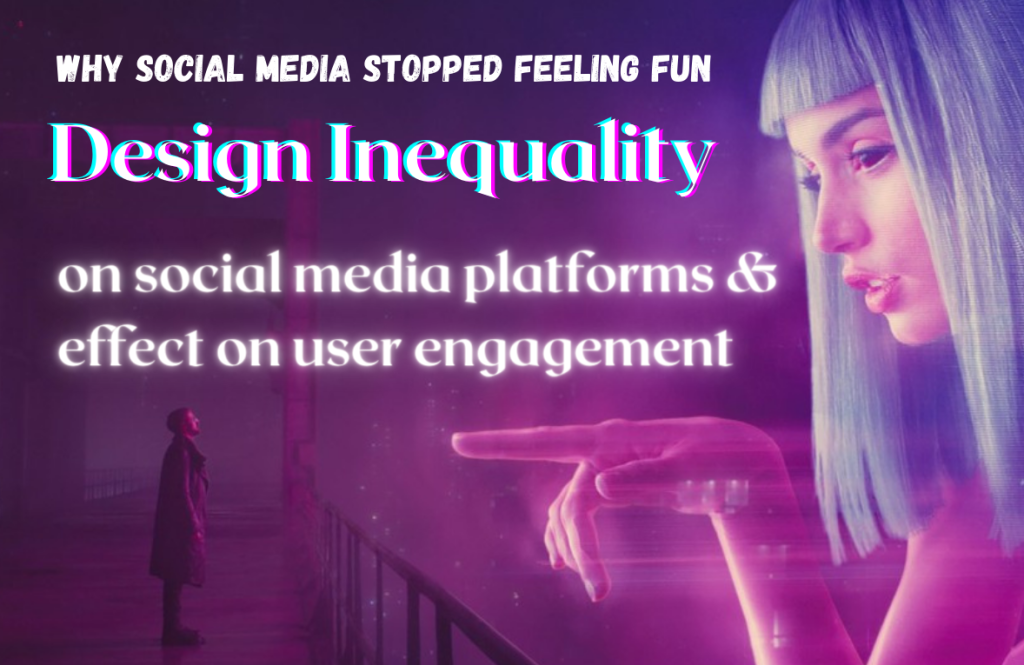This post “Design Inequality” first appeared on my personal blog: Howlite and coffee on August 21, 2021

This idea for this post came form the discussions on tumblr allowing (a selected small number of) users to monetise their posts. It was a pilot to try out a potential new feature.
The pushback for this had many points, but the most interesting was:
The best thing about this platform is that everyone is the same. We all get the same experience.
This got me thinking.. is design equality a hidden feature in some social media platforms?
What is the impact of design inequality on our experience of the platforms?
What is Design Inequality?
Design inequality is the difference in platform features and behaviour for different users based on status.
It can be a status that is determined by staff, like the manually approved blue checkmark and “verified accounts timeline” on Twitter, or it can be “earned”, like swipe up links for people with 10k followers on Instagram.
It might be self-selected, like the different options available to influencer or business accounts over “normal” accounts for Facebook and instagram.
It could be different standards by which some accounts are suspended or shadowbanned based on who the user is, not the content posted.
What is the purpose of design inequality?
For the platform:
- The main drive is to incentivise users to “strive” for influencer status, encouraging more engagement. Engagement is the lifeblood of social media apps.
- Encourages big accounts to stay and use this platform as their primary social account because of the reach/ results. Social media platforms are in competition with each other for being the main platform. No one has time to be on all platforms equally.
For the users
- Ability to monetise from the platform.
- better reach and engagement for their investment of time and money
Effects of Design Inequality: net harmful
Design inequality is degrading the experience of the platform and user engagement with the platform over the long term:
- Creates cynicism and distrust in the users. Even during their recreation time, they have “elites” and “have nots” status shoved in their faces, and different outcomes for the same behaviour depending on clout. Their “escape place” behaves too much like the real world to be a real escape anymore.
- Influencers have disproportionate power to sway opinions over more qualified people who don’t have the same features due to followers.
- People who are more qualified must first spend many days attempting to build a following before being able to counteract misinformation. While still not having the reach and ease of clicking external links as influencers.
- This has the effect of strengthening cancel culture (as opposed to simply unfollowing). Because a post with a link is not just “an opinion” when shared by someone with powers “regular” people don’t have: their opinion is a show of power and with that power, users expect responsibility. The pushback can be justified at times, but can also be driven out of spite at the “elites” in other times.
- This manifests as arguments in comment sections. The platform simply sees “engagement” and boosts the problematic accounts further.
- Controversial, covertly racist and/or misleading accounts are thus favoured over more thoughtful content creators.
- This is fatiguing for the users, since working to create nuanced and simple but informational content is less rewarding than simply sharing polarising content or hot takes.
- Positive reinforcement for increasingly toxic behaviour, through algorithmic boosting for controversy and arguments. Likes and follows from bad behaviour act like clicker training. People double down because it works.
- B.I & POC creators are leaving insta and clubhouse for platforms like patreon and fanbase.
When your escape place is no longer fun and light, you seek out a new escape place.
Enter tiktok. Where everything feels a little unpolished. Less salesy. The algorithm feels fairer. Everyone gets a little sunshine on their content.
Instagram sees this and thinks “reels are the solution”. Not recognising the emotional need for fairness.
Twitter sees the growth of clubhouse and “twitter spaces” are the solution.
But reels and spaces are just the medium of platforms that feel rich with opportunities to grow.
Platforms where cracks of inequality aren’t yet visible. Until they are. And the illusion of that level playing field is broken again.
When insta adds reels to their platform, the reels carry ALL the same problems that all content on Instagram does. It’s not cute or fun like on tiktok, it’s just more noise.
It’s more ways to be sold to.
It’s being asked to do more work on a platform that doesn’t feel fun anymore.
As of time or writing, fanbaseapp has reported a quarter of a million account migrations from insta in 2 days.

Design inequality is what’s ruining this experience. Not the features.
Update. Fanbase has since secured it’s second round of funding this march, at 2.6 million. Instagram is still holding it’s number 2 position as a social media site -after Facebook- but is expected to lose that in the Middle East and Africa to tiktok. Mastodon has gotten a lot of interest lately, with the European commission creating a european instance for official EU bodies. I don’t expect it to replace twitter, however, as it’s less intuitive, and because it’s less easy to have a big following, making it less attractive for businesses, celebs, and trolls – the Twitter trifecta.
Moodthy Alghorairi is a product designer and digital consultant behind Wyld.Media. She’s been designing digital experiences since 2002. She’s a runner, mama to Floki (8 y.o parrot) and Thais (3 y.o human), and head geek at MadridGeeks.es. Follow her on social media below, or sign up for the newsletter to get new posts in your inbox.
Leave a Reply